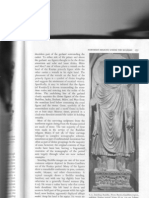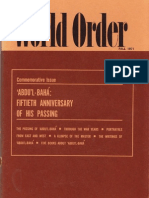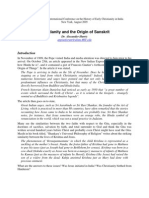Gedige
Gedige
Uploaded by
mahiyagiCopyright:
Available Formats
Gedige
Gedige
Uploaded by
mahiyagiOriginal Description:
Original Title
Copyright
Available Formats
Share this document
Did you find this document useful?
Is this content inappropriate?
Copyright:
Available Formats
Gedige
Gedige
Uploaded by
mahiyagiCopyright:
Available Formats
r26
JOURNAL, f{..\.s. (( Fl'r.O-\)
(Vor. XXXVI.
t'{o.9q--1945)
GNDIGE
127
GEDIGE
By S. PanRuavtrlna
i
A number of ancient buitdings in Ceylorr, belongiug to ciilTerent periods, and situated in various parts of the island, are known tc;<lav bv the name ' Gedig6'. A ruinecl brick structure within tire citadel of Anurddhapura and the remains of a shrine of stone construction in the village of Ndla.nda in the Md.tal District, are known b-v this name, while a Gedig Viirdr:r is situa':ed near Kandy. The Galmaduva and the Larikd.-tilaka temples,
present, these tr,vo shrines are not usualll. referrecl to, in writings, by that appellation. In none of these instances is there anv evidence to show that ' Gedig6 ' r'vas the name giver:r to it by its builclers and the interpretation of this name has given rise to considerable speculation: In his detailed description o{ the Gedig6 at N6lancla, Bell has expressed his opinion that " the origin of the na.me is doubtless found in the Tamil vernacnlar gaiS,itai, or in the Sanskrit ghntika". He has also quotecl
and Krishn:r :l Sastri' rvlrich is based purer.r'on tlre ii-it"rity of sorincl, to me as prausible. on tne other hancr, th".'" h;;iil;;; ao"= nrt appear ff,h""l,,ncie't riteraturc of the island, which, i,r *i-trin_ton, concrusiverv establisires ,rtrached r{, tt,; \vn;; si[ipa br. the p;;p[;f i.;rton in :ij.:t-t'jr:l.rrce
mo'uments now known, or at one time known,- by the name of Gedig does' trrerefo'e' appear to have "u"rpoir"r.ef lhe character of the class of estabtishments known as staatikds, i" so"tt i;g1;."ir?i trr""itri"nry ,"_ sarding the origin ,]l: name GeQigi, sug.gested by Bell
bpth in the Kandy District, have been knorvn as Geq1ig6s, though, at
-rI(1ijri;u-"n:i[ayn 1n.'r.s. cai,r""l n. :o5) is cluotecr as arr iilust'atiorr. itr," si"'t"i"se explanato.v s",i,r" of tlre Rtipasiddhi, a w.rk w.hich has b..";;;l;; as an aurrority bv tire cet"brarert schr-rlar- Sri Ri.lr'lir ot tr," nli*J,lL i.ntorj:;"'ni, p"i;riia ))ra,tipn, a.'d which, from its language, seems to nave the ccrmposition of tni napaiiiii; ;;'th; beJn w;rtt;;,;;;;;;g after seconcr half of centurv,r comments o' the word Giijai;;orrii;-^;'i;it"*, ,1e twerfth ,,i:
ir"yona of doubt tlrat the word.qt(ti*i-*e.,,,, tn" Rnpasiddhi'sawte' i'e.. i,i p";il' rr.tru.",r rhe rzth ,nJ-it" ,5tn centuries, a building of i qirtjcu-:4;1p" "i "*Utecture anct tir:rt the w'rd wars considered to be eqriivalent i" J.*iis to the pali
In the Pali grammar_Rd,pasiddkr. of tsuddhappiya, tlie sentence ,, Ekait. sLunct'ya'it Bltagautr :\'rldihc uiltar,rti ciiiinai,iritr,.,j''#rlri"*,1,, rhe cfrtagosinga sutta o[ the
the opinion of Rao Bahadur Krishna Sastri, the late Government Epigraphist for India, which is as follows :* " Thr word gaiS,igai is not nolv used among the 'lamils to denote any part of a. temple. Ce{i-ge may, however, be n derivative of the Tamil ge(.i or gaSinai, the {ormer of wtrich denotes'halting place' 'rest-house' and the latter ' the alms-disli of :r religious mendicant'. i\tiy strong conviction is that the rvord has to be connected with Sanskrrt gh,atikd,, corrupted in the vemaculilrs into geQige or gaiQ,igai. 'l'he term occurs in man5r inscriptions, and alwal's in connection rvith impr:rtant centres of learning-.el1ntiha,-stlt&na being a high attribute conferred on a town. " There is also reason to believe that theseg/za.tikds were attachecl to temples. 'Ihe town Kairchi, for instance, was a glttttika,-sth,ar'ta. Sholingur, a station on S. M. and M. Railwarr, is still referred to in Sanskrit worl<s as Ghatihdchalo", evidently meaning a place llt which, on a hili, was once locatecl an institution of the kind in question. I have mentionecl in m1' Repc-,rt for rgro-rr (page 5t, pu.og.iph 7) 'the ghatihci o{ IJrahmanas'.
je(igetti., (rneans) in thc buircling which ;;s ."'*l*.r"a entireh of brick, th*t is "r'his.refe;;; to s..v in rhe Gedigd ". 'r""^pilrrrririry ;;r"brist"r
Ciiijahduasalhe. sivnltt ttlu-nttru|i !elti
ltetal
,.Gifijak,iasollrc
ift
,iL" tl;;'Ji;;";.itll,"J.i
" 'lhe terni occLLrs ir:r the'lalguncl inscription of abciut the sixth centur-\, A.p. Frofessor- Kielhorn (E.pi,graph.ia Indiaa,p. 35)' is of opinion that it denotes an establishment (probablv founded in most cases bv a king) for holy and leamed men. There catn, therefore, be little doubt tiiat the
ruined' gaid,igai' at Ndlanda does represent an institution of the kind "." The Gedige at Nalanda, though it is buiit in the Pallava st'n'le of architecture, is, in l.rll probability, a Buddhist shrine. 'Ihe ruins of a strlpn by its side prove this fact. The Gedig at Anur5.dhapura is a part of the Sinhalese royal estzrblishment and the Gedige at Kanclv is a Buddhist shrine built in the lifteenth centur_v'. I-anka-tilaka is a Bucldl'rist shrine built in the {ourteenth century while Galmaduva Vihdrir dates, according to tradition, from the reign of I{irtti Sri Rljasiri-rlia. None oi the
Tlre explanation of.^tbe_ ylord Gifija.kytas_atln b-v the author of the Riipasiddhi-san*e is in agreement ivith that of Budclhaghosa, who irr his cc-,mnrentar\. toJh!-Viijii""'"ithiya_,,*tates: Gifr,jukduasathe. ti irthahamaj'e ai'asa!rte. m"t*ii''nir)"'o,',,rri'st,og^ii,ill,air'r'llrlircot,n,;, liaronlo vaj.jilq.tlhc carihan't, car*ntaito""'Nadirrn,n,)tltth^nttn \r t,',tsitto wanuisd Eitosuuttt.o ntahu,t,Trtni joi,i aiii'i*'ln,i,iil!i,li,',',?o h;ur;'!;:,';_ ltaduyi Sarthu i,trsuttattrtdnarit harissiii,T:i" t,mtttctra i*/tnhdrtira bhitti_ . sofidnn-rltambha-rirantpartrtti dassritii iiraiii iri)u'';',,ii'ii,,'r"'ri*prtr,, tnaldhantma-la!akarrndtrt,i y;y:li,ijrira ''"iii,,,,*nttt,nvatttr-tnctii'ctr_ftttltddltti pr,r'iiapetvti Sattlw niyt,qtesurix.i ,;.'i;;;(i;r"a'sathe built of bricks'. onie upon a time irre-"g'i;ecl nteans, in the i-esidence one, to.ring the vajji courrtr\- in trrc c"lll'se of l,ris ptttrt;c f iirr peopre of Naclika gave.arms i" ti;; ,,,iniitr-rtrrrn. arriveti at \adir<ri. R;dha, rirt"n.Iio iiJaur"*5,, trr the l)lrammrr . rn.i b"ing,,rtf,"i,""iii'i,"rrr. t,,rk corrrrslJ irrnong tlremsel'cs (and res,,r'ccr)..th-at ttre-i'lrlrrrt,t.t' const'rct a prircc of resi_ ttence I,r the Te;rcher ii-; "iiin.. -n",ui,ig "*r)rr," nigr,,, -i.;a ," r'I steps, pillars anrl fisures of )-,,,,/,i.'c,,,i-,.r.t",r of brick rrlop1.. plxsf6spll tt witlr lime, comoret"x it= o..oi"iiu,''r'riin'i*t;e"r rf wirh carpets, r,.ar,' ln"t;:;, ";;.., andflowers ",,i[r""p"r., cteclicated it to the +:::;::+,t,
Gifi,jakavnsathct,.
:;,r"o:!:;1!Xl:.i"".T:lT*,:I#Ty,f -"}if ::-to-tlrethirteenthccntur-y.butinarl 'ii:'1".i;t',:fii3t It'a""srro"n.irri;d;;#;?i::rT;';^:'{iX";r3!:k1i;, ,';*.,i;j.1,;';E i{l:;i^T)i:,iijiii;.Y;:;;;'\,;:'{t',J',',': {l
2. 3.
Mahartipasiclcthi Sunne Colombo, 1927, Savatthappahd.silzi, p. T.
S.
t. Vol. VIIf ? -fhe reference to the Volnme does not occur in Beil's report z. Annual Reporr o.f tlre Arch.eeological Suraey oJ Ceylolr, rgro-rr, p. -5o.
p,
164.
Eclition. part z. p. zj-5.
--a
JOLrR\rAr-, R.A.S. (CEYLON)
(Vor. XXXVI'.
(io. 99---.rqa5)
nneans ' residence
GEDXGE
1-29
ancient iomrnentaries which contained exegetical materia.l going bach Sinha.lese io a stiil etrriier age. The tradition of the architectural character of the Gifiiakavasatha wliich he has embodiecl in his commentary rnay, therefore, Ou,j". which rvas bn,rught to Cc1'l,rn bv the ealliest Rrtddhist inissionaries rpnro can-le to tiris isiancn frc'rn Nr'rrth Inclia. Frclm the clescriptierns of p:rlaces and other important edifices occurring irn the Fifakus,,,rie geis tG impression that the architecture of ancient l^al" a*furg the tirie of tl.re tsuciclha rvas essentially wooden. This is ,fu,t tfr" coiclusion ttrat has beei.r arrived at bV an examination of the
tsudclhagtrrosa rvrote in the fifth century, but he utilised
the
earlies'} monumerltal remains in India. But the Gifljakdvasatha seerns t r have belongecl tr.t, a cliff erent type of architecture. As it is said to harte U."m .otrutr1ritecl entirei,v of brick, it rnust have he"d a vaulted roof. The hrick vault, as an archltecturatr feature, seems therefore to harte been knor.vn in India in the time of tl-re Buddha. No actual example of a Uo;.L i"u"ft clating from such an early period has been.prese-rr.ed in India, L,"i ilr" ren'ra.ins at }lohenio-claro sl]oiv that the principle of the corbelled' lu". knorvr-r to tlie huilclers of the hidus Valley in the third milleniurn
oy rlie jnfluence of an v in the pneceding or'following .viri,n]". ft,1, ln the present instance. ]rrstalrces, Iiowever, are not atrtogether wanting in which a d has been cerebralisecx withoiJ socn ar, influence. compare_for instance sintraiese Qah,a .[.or p. and s{t-. aana Jnr the compound daha-diyo nrcdern (.dd{ta' sweat ' ;
reature_rs wantlng Tn rnodern sinhalese,thg word gediga is arso applied to an . orntrmenta,l pcng*la or kiosk ernbellished by-flowers ana fiuits'. Tiresc temp,,rary 1]rlictgre;, put up for festive occasions rvith bamboos, areca_Dal'ms or tright tim-ber, are usually hung with bunches of coconuts and ottei rruit.
gifi,jak_d.aasatlatz, the se,i:ond nremtrer d:uasatha or ' house ' and has the sanre *g"inc""." ,, l;"'i, ttu" sinhalese ge!.i'ge- Pali giii.iaka,. tl'rerefore, corr.sp.rnd, ,o.cratl" si""halese. ovr_the analogy o{ th9 Sanskrit kifijarka, p. h;iijahkha,'rreco*;ne r.r?a; in sjntralese, P. gifija-ka can assurne thc fornr .i:ia;. tn'ts-ir*i".in gi"" rise to the^form sed! by the cereirralisation of d, rvhich u.""rtu i, ca,rsea
ln the Fali.cornpound \rrord
'
"uuti B.C.
clf the Ge<iig6-r knr,rwr-l ttr erist in cer'lon, the monument of that narne to be ,.eeru at-Auuradha.pura corresponds rtery rvell to thc definition of
'.irl.-rr3o*i-frnn
in rlle Iliitltosiddhi-sottne. .\pari from the door-1rames, es and steps., rvhich are of stone, the building is .entireXy *f Url.fo construction, woocl having hacl no place in the architectural ."fr.*., even for tire roof. The sprlnging of the dome which roofed the erlifice can be noticed ire tXre portion of the building still preserve.d- The i-mfia-tifnf," is aXso oi'brick*construction, save foi the base r'vhich is of ;;;;;. Of the Gaknaduva tempie the r:ault is of brick construction wtiitre
pcdiuE'gir-en
the
brase
is
r..rf stone.
t-lruiliur" appears that tUe terin. teSigA r,vas -first app]ied to brick-built but, at a. later <late, the distinguisl'ring characteristic
C*+rgC at
i['he other
tu,'er Gecliges are built of stoire, but in con1mo_ll rvith tire AnrLrradh*1riotu, thel'' are.provided with vaulted roofs' It
"r"fi"A =ttlitot"r to be the vaulted constmction of the roof and not the a{ i geSige was ta}ieit rnateriai c,f wlaich the edif,ce rvas built. The application of tlie term rvas in*r.it""a"d to vaultecl edifices of stone, as rvell as of brick construction' were
(]ed'i in Sinhalese means 'fmit' or 'nut' a'd gertigE n ;Itoii-to"..'. llhe terrn rrray therefore be a modern one inventecl to suit the nature of tlhese ornarnental structures and have nothjng to do with the tural ter-rn geQ,igE- loand in the R$,pasiddhi-siiute, the irJentitv^r.Ht".in forrn "between the.trvo lreing punely accidental. On the other hand, tLe re.rense i"s a,lso possible. llvery s$ige is not necessarily hung witrr'buncrles of fruit. sorne are decorated with tender reaves orf th" irrto various onirarnerrtatr designs; briglrt colorrred tissue papei oiid.lotr, "i.on"t fnr*l*"au lra,,'e entered rno.e and nrore irtn rhJdecorarir.e scherne of'thesc qe(igts rn recent tirnes. llsselitiaily, a motlern gcrligi is o* orno**niol of a ternporary nature. It is possib,le that ^n.tr arches of this type, 'nialneiltal a. perrnanent character, exilted in ancient days, ir"l front of t"*01". ;;a "rf palaces.-,The ter*r *sed to bnildings ot the same type as the Adunadha'pura ge{'igE- could have been extended to thern. W}len tenaporuru o**r,'rrental arches were constructed tlaey were also givell the surri* ,rnire ,ryhen the original me-aning of the woid trad "rd been"forgotrera, loilr-etiiiotogy interpreted the word to rnea' 'fru.it-house' ar;c1 f,he o"itor' ilr;^-rrlgi::aterl of decorating such structures with tnrr:ches ot' fruit, ira or,ler to lustrfy the narne as it was populanly r,indenstorid.
.ancient edifices in cel'I"n, rvhether tirerr '*vere of brick or of stone, ..u:"*lfu pla.stered ove; i1lld tbre nraterial of their construction vrould not lon"o U.;" eviCent tt.r tire people rvho saw tirem when thev were in a- good it^te of n-laintenallce. The eiterior forrn of an edifice, on the other hand, *ii"ianot'" been the characteristic to be r-roticed more than anvthing else as the ;rnttr it rnust have had as much to clo in tlre applicartion of narnes .lvhich it r,vas [tui]i. we p-lav, therefore, conclude that a materlat of C"eGe at first signihectr a brick-built eriifice rvith a vaulted roof and later ,,-r, ilriilcline of t-'trat architectural forna, rvhether built of stone or brick. 'ilr'* rn*" therelore trlas nottrring t,l clci *'ith the purpnse rvhich such a
bulldlnq sel-YeG. had tlrc sittrte siStrific;ince ll I i- llrus tleor :1,-i lhc:inl,al.:.e tt rlrqcrlige it * e.ll g;Ai*,taussalltt:r.. it is, hor,vever', nc,t so certrtin whether ^, -(i;r11,xl;..'lvrirci is etynroJiosiciiXl-r' connectecn rvith its Pali cr-runterpart' li-1"
You might also like
- Peter Trudgill, The Dialects of EnglandDocument5 pagesPeter Trudgill, The Dialects of Englandmahiyagi100% (1)
- Peter Trudgill, The Dialects of EnglandDocument5 pagesPeter Trudgill, The Dialects of Englandmahiyagi100% (1)
- Jataka Parijata Vol 1 3 PDFDocument1,094 pagesJataka Parijata Vol 1 3 PDFSiva Prasad Tata100% (3)
- SymbolsDocument13 pagesSymbolssoloiosochisono66% (32)
- Jataka Parijata Vol 1 3Document1,094 pagesJataka Parijata Vol 1 3TanmayNo ratings yet
- Interim Report On The Operations of The Archaeological Survey at Sigiriya, 1897.Document27 pagesInterim Report On The Operations of The Archaeological Survey at Sigiriya, 1897.Ratnasiri ArangalaNo ratings yet
- A Guide To The Reading of Ancient Indian Coin Language - DevanagariDocument10 pagesA Guide To The Reading of Ancient Indian Coin Language - DevanagariResackNo ratings yet
- Sinhalese Magic and SpellsDocument10 pagesSinhalese Magic and Spellsmahiyagi100% (1)
- Barua Barhut InscriptionsDocument149 pagesBarua Barhut InscriptionsRoberto E. GarcíaNo ratings yet
- Art of Ancient India CH 4 PDFDocument50 pagesArt of Ancient India CH 4 PDFzhigpNo ratings yet
- Pre Buddhist Religious Beliefs in Ceylon.Document15 pagesPre Buddhist Religious Beliefs in Ceylon.darshanieratnawalliNo ratings yet
- A Note On The Janakiharana.Document4 pagesA Note On The Janakiharana.darshanieratnawalliNo ratings yet
- Brahmi Inscriptions in Sinhalese Verse.Document5 pagesBrahmi Inscriptions in Sinhalese Verse.Pradeepa SerasingheNo ratings yet
- Ceylon and Malayasia in Mediaeval Times PDFDocument22 pagesCeylon and Malayasia in Mediaeval Times PDFdarshanieratnawalliNo ratings yet
- Pre Buddhist Religious Beliefs in Ceylon PDFDocument15 pagesPre Buddhist Religious Beliefs in Ceylon PDFdarshanieratnawalliNo ratings yet
- Brahma Sutra Sankara Vasya On CasteDocument7 pagesBrahma Sutra Sankara Vasya On CasteMuktipadaBeheraNo ratings yet
- A Short Account of The History of Irrigation Works Up To The 11th Century.Document15 pagesA Short Account of The History of Irrigation Works Up To The 11th Century.darshanieratnawalliNo ratings yet
- Two Sinhalese Terms of Kinship.Document4 pagesTwo Sinhalese Terms of Kinship.Pradeepa SerasingheNo ratings yet
- Art of Ancient India CH 1Document50 pagesArt of Ancient India CH 1zhigp83% (6)
- Koil Ozhugu SriRangamTempleDocument35 pagesKoil Ozhugu SriRangamTempleRaviNo ratings yet
- Humphrey William Codrington.Document2 pagesHumphrey William Codrington.mahiyagiNo ratings yet
- Chase 1902 - The Shield Devices of The GreeksDocument68 pagesChase 1902 - The Shield Devices of The GreeksVLADIMIRONo ratings yet
- Pre Buddhist Religious Beliefs in Ceylon.Document15 pagesPre Buddhist Religious Beliefs in Ceylon.Ratnasiri ArangalaNo ratings yet
- The Unknown Life of Christ EbookDocument69 pagesThe Unknown Life of Christ EbookGabStar CalNo ratings yet
- Inscribed Pillar Slab at Nuwara Eliya.Document4 pagesInscribed Pillar Slab at Nuwara Eliya.Ratnasiri ArangalaNo ratings yet
- Chapter 13 Readings - 0001Document11 pagesChapter 13 Readings - 0001kung_pao22No ratings yet
- Art of Ancient India CH 5Document51 pagesArt of Ancient India CH 5zhigpNo ratings yet
- The Early Iron Age and The Eighth-Century RevolutionDocument37 pagesThe Early Iron Age and The Eighth-Century RevolutionGR HectorNo ratings yet
- Banani Article Abdul BahaDocument13 pagesBanani Article Abdul BahaBVILLARNo ratings yet
- Arthur Maurice Hocart.Document3 pagesArthur Maurice Hocart.mahiyagiNo ratings yet
- The Tantra of The Great Ganapati - Ganesh in Tibet by Christopher Wilkinson S.U.N.Y.-libreDocument46 pagesThe Tantra of The Great Ganapati - Ganesh in Tibet by Christopher Wilkinson S.U.N.Y.-libreWilliam D. Jackson III75% (4)
- Galapata Vihare InscriptionDocument8 pagesGalapata Vihare InscriptionALEX johanNo ratings yet
- ,4 Foundations Oi Indic Civiliz.,/Tion: Orrrll Inrrcexous Tren-Ds: Megalrrrrrc Il - Nuarrqs or Souruetn IulraDocument50 pages,4 Foundations Oi Indic Civiliz.,/Tion: Orrrll Inrrcexous Tren-Ds: Megalrrrrrc Il - Nuarrqs or Souruetn Iulraapi-19731771No ratings yet
- 08 - Chapter 4Document50 pages08 - Chapter 4riyamirza36365No ratings yet
- Papers On Satrunjaya and The JainasDocument13 pagesPapers On Satrunjaya and The JainasKimNo ratings yet
- Art of Ancient India CH 11Document53 pagesArt of Ancient India CH 11zhigpNo ratings yet
- Note On A Few Words in The Vedda Languge.Document4 pagesNote On A Few Words in The Vedda Languge.Pradeepa SerasingheNo ratings yet
- 07 - Chapter 3Document60 pages07 - Chapter 3riyamirza36365No ratings yet
- Siddhanta Deepika Volume 12Document557 pagesSiddhanta Deepika Volume 12BosRajNo ratings yet
- Siddhanta Deepika Volume 12Document557 pagesSiddhanta Deepika Volume 12SivasonNo ratings yet
- Two-Dimensional: MediaDocument16 pagesTwo-Dimensional: MediaYen Peng TanNo ratings yet
- Atahualpa and The BookDocument15 pagesAtahualpa and The Booktinchote68No ratings yet
- Adam McLean - A Rosicrucian-Alchemical Mystery Centre in Scotland (The Hermetic Journal No. 4 Summer 1979)Document3 pagesAdam McLean - A Rosicrucian-Alchemical Mystery Centre in Scotland (The Hermetic Journal No. 4 Summer 1979)gustavmeyrinkNo ratings yet
- Benoytosh Bhattacharya (Editor) - Sādhanamālā, Vol. I (1925) PDFDocument362 pagesBenoytosh Bhattacharya (Editor) - Sādhanamālā, Vol. I (1925) PDFPadma DorjeNo ratings yet
- The Ancient Emporium of Kalah in The Empire of Zabedj.Document15 pagesThe Ancient Emporium of Kalah in The Empire of Zabedj.samaanNo ratings yet
- Some Documents of Vikrama Bahu of Kandy.Document6 pagesSome Documents of Vikrama Bahu of Kandy.darshanieratnawalliNo ratings yet
- On Vamana Datta - Raffaele TorellaDocument13 pagesOn Vamana Datta - Raffaele Torellaraffaeletorella100% (2)
- Upulvan Shrine at Devinuvara PDFDocument4 pagesUpulvan Shrine at Devinuvara PDFSaman M KariyakarawanaNo ratings yet
- UDŽBENIK 06 Skulptura 4.st.Document29 pagesUDŽBENIK 06 Skulptura 4.st.YeyaNo ratings yet
- Turks Mil ThesisDocument100 pagesTurks Mil Thesisnavneet kaur syanNo ratings yet
- A Scene in The Realm of The DeadDocument11 pagesA Scene in The Realm of The DeadAtraNo ratings yet
- The Tale of Gyges and The King of LydiaDocument53 pagesThe Tale of Gyges and The King of LydiadeepanNo ratings yet
- What Does It Mean To Think Historically and How Do You Teach ItDocument4 pagesWhat Does It Mean To Think Historically and How Do You Teach ItKamille SarmientoNo ratings yet
- Oral Interview - Dorothy G. WescottDocument36 pagesOral Interview - Dorothy G. WescottCAP History LibraryNo ratings yet
- Coates 1968 Rizal Philippine Nationalist and Martyr Part 1Document51 pagesCoates 1968 Rizal Philippine Nationalist and Martyr Part 1antimbolNo ratings yet
- Myths and Symbols in Indian Art and CivilizationFrom EverandMyths and Symbols in Indian Art and CivilizationRating: 4.5 out of 5 stars4.5/5 (2)
- Calendars and Years II: Astronomy and Time in the Ancient and Medieval WorldFrom EverandCalendars and Years II: Astronomy and Time in the Ancient and Medieval WorldNo ratings yet
- The Moths of the British Isles, First Series Comprising the Families Sphingidae to NoctuidaeFrom EverandThe Moths of the British Isles, First Series Comprising the Families Sphingidae to NoctuidaeNo ratings yet
- Rethinking India's Oral and Classical Epics: Draupadi among Rajputs, Muslims, and DalitsFrom EverandRethinking India's Oral and Classical Epics: Draupadi among Rajputs, Muslims, and DalitsRating: 4 out of 5 stars4/5 (1)
- First Kill The Language, Then The Culture When A Language Dies John RossDocument4 pagesFirst Kill The Language, Then The Culture When A Language Dies John Rossmahiyagi100% (1)
- Berent Et Al 2002 CognitionDocument27 pagesBerent Et Al 2002 CognitionmahiyagiNo ratings yet
- Sri Lanka Association For The Advancement of ScienceDocument1 pageSri Lanka Association For The Advancement of SciencemahiyagiNo ratings yet
- Yamuna KachruDocument17 pagesYamuna Kachrumahiyagi100% (1)
- Semantic NumberDocument55 pagesSemantic NumbermahiyagiNo ratings yet
- Did You KnowDocument23 pagesDid You KnowmahiyagiNo ratings yet
- Sri Lanka Deforest in NorthDocument3 pagesSri Lanka Deforest in NorthmahiyagiNo ratings yet
- Poverty DefinitionsDocument3 pagesPoverty DefinitionsmahiyagiNo ratings yet
- Postmodern Literary Theory and Translation by MarthaPulidoDocument20 pagesPostmodern Literary Theory and Translation by MarthaPulidomahiyagiNo ratings yet
- Arthur Maurice Hocart.Document3 pagesArthur Maurice Hocart.mahiyagiNo ratings yet
- Reasons and Motivations For Code Mixing and Code Switching by Eunhee KimDocument19 pagesReasons and Motivations For Code Mixing and Code Switching by Eunhee KimKayra Moslem100% (5)
- Women Under Primitive BuddhismDocument2 pagesWomen Under Primitive BuddhismmahiyagiNo ratings yet
- Medical Establishment in Sri Lanka During The Dutch Period (1640 1796) PDFDocument5 pagesMedical Establishment in Sri Lanka During The Dutch Period (1640 1796) PDFmahiyagiNo ratings yet
- Personal Computer Hardware System & OperationsDocument60 pagesPersonal Computer Hardware System & OperationsmahiyagiNo ratings yet
- Obituary Professor Jean Philippe Vogel PDFDocument2 pagesObituary Professor Jean Philippe Vogel PDFmahiyagiNo ratings yet
- Book Review Gods in Early BuddhismDocument1 pageBook Review Gods in Early BuddhismmahiyagiNo ratings yet
- Obituary Cyril Wace Nicholas.Document2 pagesObituary Cyril Wace Nicholas.mahiyagiNo ratings yet
- Zarathushtra and GathasDocument298 pagesZarathushtra and Gathasmahiyagi100% (3)
- A Pali Document in Cambodian Characters Found in The Malvatte Vihare, Kandy. K.D.ParanavitanaDocument4 pagesA Pali Document in Cambodian Characters Found in The Malvatte Vihare, Kandy. K.D.ParanavitanamahiyagiNo ratings yet
- Humphrey William Codrington.Document2 pagesHumphrey William Codrington.mahiyagiNo ratings yet
- The Rise of The NovelDocument8 pagesThe Rise of The NovelmahiyagiNo ratings yet
- Christianity and The Origin of SanskritDocument10 pagesChristianity and The Origin of SanskritmahiyagiNo ratings yet
- Chapter 3 - DhwaniDocument59 pagesChapter 3 - DhwaniJay MjNo ratings yet
- Marxist Criticism & Fredric JamesonDocument14 pagesMarxist Criticism & Fredric JamesonmahiyagiNo ratings yet
- Sanskrit BuddhacaritaDocument121 pagesSanskrit BuddhacaritaMahender Singh GriwanNo ratings yet
- SAMPLE FORM 03 MASTER EMPLOYMENT CONTRACT With Salary Breakdown List of Duties CriteriaDocument5 pagesSAMPLE FORM 03 MASTER EMPLOYMENT CONTRACT With Salary Breakdown List of Duties CriteriaJane Ofenda100% (1)
- "Cathedral" Is A Short Story by Raymond Carver That Was First Published in 1983Document25 pages"Cathedral" Is A Short Story by Raymond Carver That Was First Published in 1983Sheilou Mae TabudlongNo ratings yet
- Pondicherry UniversityDocument42 pagesPondicherry Universityanchor newsNo ratings yet
- Disarmament 1Document34 pagesDisarmament 1IlmuncMakesuillNo ratings yet
- Linguistics Offenses and PrejudicesDocument52 pagesLinguistics Offenses and PrejudicesMark Christian CatapangNo ratings yet
- Carousing Results: Jeff RientsDocument1 pageCarousing Results: Jeff RientshigherdepthsNo ratings yet
- Batch 2 CasesDocument55 pagesBatch 2 CasesCar L MinaNo ratings yet
- A Play About: School UniformsDocument12 pagesA Play About: School UniformsMuhammad ArsalanNo ratings yet
- Reading The Fathers TodayDocument12 pagesReading The Fathers TodayakimelNo ratings yet
- Imc Project On Coca ColaDocument15 pagesImc Project On Coca ColaAnkkit PandeyNo ratings yet
- The Ego-Principle (Ahamkara) As A Key Concept in The SamkhyakarikaDocument8 pagesThe Ego-Principle (Ahamkara) As A Key Concept in The SamkhyakarikakartoukNo ratings yet
- Invoice OD109172599294660000Document2 pagesInvoice OD109172599294660000Abhishek KumarNo ratings yet
- Basic Complaint Letter To A Tour CompanyDocument3 pagesBasic Complaint Letter To A Tour Companylee hoangNo ratings yet
- Analisis Kesalahan Berbahasa Bidang Morfologi Dalam Laporan Isu Hoaks Corona Virus Oleh KOMINFODocument15 pagesAnalisis Kesalahan Berbahasa Bidang Morfologi Dalam Laporan Isu Hoaks Corona Virus Oleh KOMINFOM. Zulkifli SaharNo ratings yet
- Godin, B. - Innovation Without The Word: William F. Ogburn's Contributionto Technological Innovation StudiesDocument56 pagesGodin, B. - Innovation Without The Word: William F. Ogburn's Contributionto Technological Innovation StudiesChaire Fernand-Dumont sur la cultureNo ratings yet
- G12 Business Finance: Module 2 (Week 3-4)Document18 pagesG12 Business Finance: Module 2 (Week 3-4)Jessa GallardoNo ratings yet
- Medical Cover LetterDocument7 pagesMedical Cover Letterafmrpairikvftz100% (1)
- Formation of The State of Bhutan ('Brug Gzhung) in The 17th Century and Its Tibetan AntecedentsDocument23 pagesFormation of The State of Bhutan ('Brug Gzhung) in The 17th Century and Its Tibetan AntecedentsDaniel MayankNo ratings yet
- Kansai Nerolac Annual Report 2018Document205 pagesKansai Nerolac Annual Report 2018TejdeepNo ratings yet
- Selection of Contract StaffDocument8 pagesSelection of Contract StaffANDREASNo ratings yet
- Objective of This Case StudyDocument10 pagesObjective of This Case StudyMariam Arshad100% (2)
- Asignment SosiologiDocument14 pagesAsignment SosiologiSaras Vathy100% (1)
- Tavilla v. Blue Cross, Ariz. Ct. App. (2014)Document14 pagesTavilla v. Blue Cross, Ariz. Ct. App. (2014)Scribd Government DocsNo ratings yet
- CV - Pablo de La RasillaDocument2 pagesCV - Pablo de La RasillaAnonymous NKWzYjgXNo ratings yet
- People Vs Mandoriao 51 OG 4619Document4 pagesPeople Vs Mandoriao 51 OG 4619Karl Odronia100% (2)
- Monitoring and Evaluating A Voluntary Blood Donation ProgramDocument16 pagesMonitoring and Evaluating A Voluntary Blood Donation Programddophlaak labdeptNo ratings yet
- BS 4875-5 2009 Strength and Stability of FurnitureDocument18 pagesBS 4875-5 2009 Strength and Stability of Furniturealan-chuah-7423No ratings yet
- The Tragedy in The Story of Rostam and Sohrab in FDocument10 pagesThe Tragedy in The Story of Rostam and Sohrab in FPedro RegazzoNo ratings yet
- Sns Rail Company ProfileDocument5 pagesSns Rail Company ProfileSibusiso GasaNo ratings yet
- Panchmukhi Hanuman Mantra, Stotra - Benefits, Meaning - For ProtectionDocument12 pagesPanchmukhi Hanuman Mantra, Stotra - Benefits, Meaning - For ProtectionVenkates Waran GNo ratings yet

















































































































